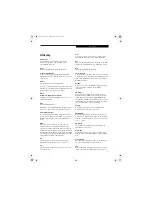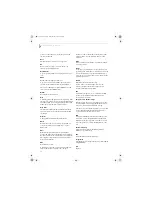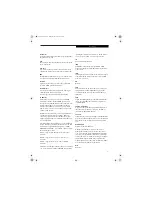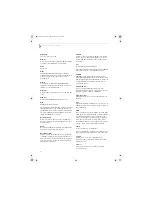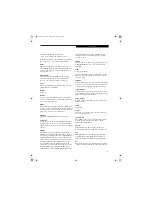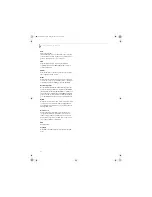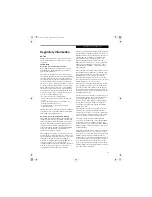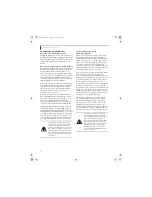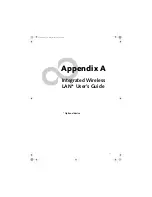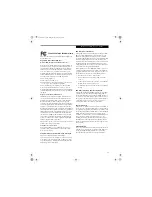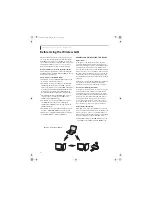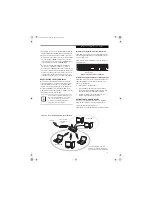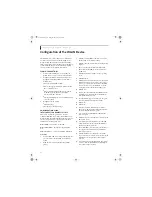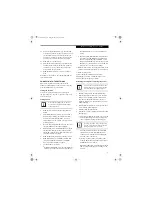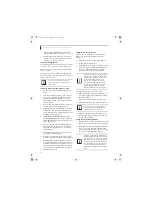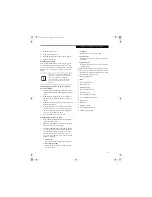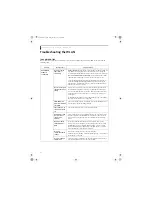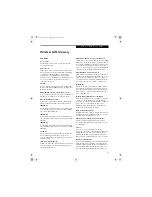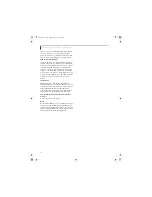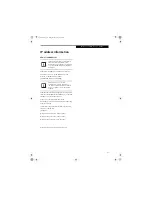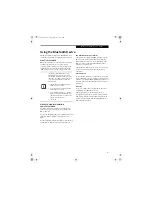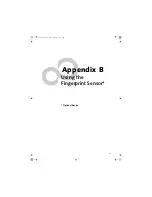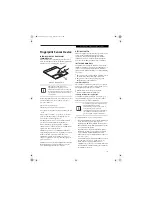
90
L i f e B o o k E S e r i e s N o t e b o o k - A p p e n d i x A
Before Using the Wireless LAN
This manual describes the procedures required to prop-
erly set up and configure the integrated Wireless LAN
Mini-PCI device (referred to as "WLAN device" in the
rest of the manual). Before using the WLAN device, read
this manual carefully to ensure it's correct operation.
Keep this manual in a safe place for future reference.
Wireless LAN Device Covered by this Document
This document is applicable to systems containing the
Intel PRO/Wireless 3945ABG (WM3945ABG) Network
Connections (802.11a+b/g)
Characteristics of the WLAN Device
■
The WLAN device is a Mini-PCI card attached to the
main board of the mobile computer.
■
The WLAN device operates in license-free RF bands,
eliminating the need to procure an FCC operating
license. The WLAN operates in the 2.4GHz Industrial,
Scientific, and Medical (ISM) RF band and the lower,
middle, and upper bands of the 5GHz Unlicensed
National Information Infrastructure (UNII) bands.
■
The Intel PRO/Wireless 3945ABG WLAN device is
capable of three operating modes, IEEE802.11a,
IEEE802.11b and IEEE802.11g.
■
The WLAN device is Wi-Fi certified and operates at
the maximum data transfer rate of 54 Mbps in
IEEE802.11a or IEEE802.11g mode and 11 Mbps in
IEEE802.11b mode.
■
The WLAN device supports the following encryption
methods - WEP, TKIP, CKIP, and AES encryption.
■
This device is compliant with the following standards:
WPA, WPA2, CCX1.0, CCX2.0, and CCX3.0.
WIRELESS LAN MODES USING THIS DEVICE
Ad Hoc Mode
(See Figure 5-1)
"Ad Hoc Mode" refers to a wireless
network architecture where wireless network connec-
tivity between multiple computers is established without
a central wireless network device, typically known as
Access Point(s). Connectivity is accomplished using only
client devices in a peer-to-peer fashion. That is why Ad
Hoc networks are also known as peer-to-peer networks.
Ad Hoc networks are an easy and inexpensive method
for establishing network connectivity between multiple
computers.
Ad Hoc mode requires that the SSID, network authenti-
cation, and encryption key settings are identically
configured on all computers in the Ad Hoc network.
Access Point (Infrastructure) Mode
(See Figure 5-2)
Infrastructure mode refers to a wireless
network architecture in which devices communicate
with wireless or wired network devices by communi-
cating through an Access Point. In infrastructure mode,
wireless devices can communicate with each other or
with a wired network. Corporate wireless networks
operate in infrastructure mode because they require
access to the WLAN in order to access services, devices,
and computers (e.g., file servers, printers, databases).
How to Handle This Device
The WLAN device comes pre-installed in your mobile
computer. Under normal circumstances, it should not be
necessary for you to remove or re-install it. The Oper-
ating System that your mobile computer comes with has
been pre-configured to support the WLAN device.
■
The Intel PRO/Wireless 3945ABG WLAN device sup-
ports IEEE802.11a, IEEE802.11b and IEEE802.11g.
Figure A-1. Ad Hoc Mode Network
E8210.book Page 90 Friday, March 10, 2006 4:33 PM
Summary of Contents for E8210 - LifeBook - Core 2 Duo 1.66 GHz
Page 1: ...Fujitsu LifeBook E8210 Notebook User s Guide E8210 book Page 1 Friday March 10 2006 4 33 PM ...
Page 2: ...E8210 book Page 2 Friday March 10 2006 4 33 PM ...
Page 8: ...L i f e B o o k E 8 0 0 0 N o t e b o o k E8210 book Page 8 Friday March 10 2006 4 33 PM ...
Page 9: ...1 Preface E8210 book Page 1 Friday March 10 2006 4 33 PM ...
Page 10: ...L i f e B o o k E 8 0 0 0 N o t e b o o k E8210 book Page 2 Friday March 10 2006 4 33 PM ...
Page 12: ...2 L i f e B o o k E 8 0 0 0 N o t e b o o k E8210 book Page 2 Friday March 10 2006 4 33 PM ...
Page 13: ...3 2 Getting to Know Your LifeBook Notebook E8210 book Page 3 Friday March 10 2006 4 33 PM ...
Page 14: ...4 L i f e B o o k E 8 0 0 0 N o t e b o o k E8210 book Page 4 Friday March 10 2006 4 33 PM ...
Page 34: ...24 L i f e B o o k E 8 0 0 0 N o t e b o o k E8210 book Page 24 Friday March 10 2006 4 33 PM ...
Page 35: ...25 3 Getting Started E8210 book Page 25 Friday March 10 2006 4 33 PM ...
Page 36: ...26 L i f e B o o k E 8 0 0 0 N o t e b o o k E8210 book Page 26 Friday March 10 2006 4 33 PM ...
Page 43: ...33 4 User Installable Features E8210 book Page 33 Friday March 10 2006 4 33 PM ...
Page 44: ...34 L i f e B o o k E 8 0 0 0 N o t e b o o k E8210 book Page 34 Friday March 10 2006 4 33 PM ...
Page 58: ...48 L i f e B o o k E 8 0 0 0 N o t e b o o k E8210 book Page 48 Friday March 10 2006 4 33 PM ...
Page 59: ...49 5 Troubleshooting E8210 book Page 49 Friday March 10 2006 4 33 PM ...
Page 60: ...50 L i f e B o o k E 8 0 0 0 N o t e b o o k E8210 book Page 50 Friday March 10 2006 4 33 PM ...
Page 74: ...64 L i f e B o o k E 8 0 0 0 N o t e b o o k E8210 book Page 64 Friday March 10 2006 4 33 PM ...
Page 75: ...65 6 Care and Maintenance E8210 book Page 65 Friday March 10 2006 4 33 PM ...
Page 76: ...66 L i f e B o o k E 8 0 0 0 N o t e b o o k E8210 book Page 66 Friday March 10 2006 4 33 PM ...
Page 80: ...70 L i f e B o o k E 8 0 0 0 N o t e b o o k E8210 book Page 70 Friday March 10 2006 4 33 PM ...
Page 81: ...71 7 System Specifications E8210 book Page 71 Friday March 10 2006 4 33 PM ...
Page 82: ...72 L i f e B o o k E 8 0 0 0 N o t e b o o k E8210 book Page 72 Friday March 10 2006 4 33 PM ...
Page 86: ...76 L i f e B o o k E 8 0 0 0 N o t e b o o k E8210 book Page 76 Friday March 10 2006 4 33 PM ...
Page 87: ...77 8 Glossary E8210 book Page 77 Friday March 10 2006 4 33 PM ...
Page 88: ...78 L i f e B o o k E 8 0 0 0 N o t e b o o k E8210 book Page 78 Friday March 10 2006 4 33 PM ...
Page 98: ...88 L i f e B o o k E 8 0 0 0 N o t e b o o k E8210 book Page 88 Friday March 10 2006 4 33 PM ...
Page 127: ...E8210 book Page 117 Friday March 10 2006 4 33 PM ...
Page 128: ...E8210 book Page 118 Friday March 10 2006 4 33 PM ...




